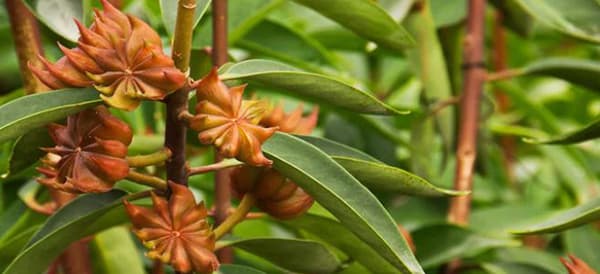
Star Anise
Star anise (Illicium verum), or Chinese star anise, is an important spice in Asian cuisine that lends dishes a sweet licorice-like taste. It is one of the ingredients of the popular five-spice powder that pairs well with many savory dishes and confectioneries. Star anise’s name illicium means alluring because of its rich and warm flavor, as well as its pleasant aroma. Aside from food, star anise is also used in some alcoholic and non-alcoholic beverages. In the cosmetic industry, star anise is an ingredient added to toothpaste, soaps, perfumes, and aromatherapy products.
Star anise is often confused with anise, but these two are genetically different plants. They do taste similar. However, star anise has a slightly bitter taste than anise. These two spices are not used as a replacement for the other. Anise is common in Western and Greek cuisines, while star anise is a staple in Asian cooking.
For more than three centuries, the star anise is a prominent spice and medicine in South China and Vietnam. It was enjoyed in many countries in Asia and discovered by an English sailor in the Philippines in the late 1600s. The sailor, Sir Thomas Cavendish, then brought the spice back to Europe. Its origin was traced back to China and soon after, it was traded from China to Russia and Germany.
Where Star Anise Is Found
The star anise is indigenous to Southern China and grows abundantly in tropical climates. They are also called badian, which means eight horns due to their shape. Star anise trees are abundant in damp woodlands and along streams and riverbanks. This fast-growing evergreen tree is frost delicate. Thus, they are not suitable for growing in areas with freezing winter unless tended in a greenhouse.
⇒ Medicinal Plant Map for Every State (Video)
How To Identify Star Anise
Star anise is known for its distinctive star-like, aromatic dried fruits. This tropical starry spice grows on medium-sized trees that are sometimes utilized as hedges in the garden. It may take many years for star anise to bear its fragrant fruits and quite tedious to grow in a cold climate. But when it starts to blossom, you will have bountiful produce of star anise for cooking and medicine.
 Leaves. The aromatic leaves of the star anise are large, lanced-shaped, and olive green in color. The broad leaves measure around 10 to 15 cm long and 2.5 to 5 cm across. They are alternate, simple, and are clustered at the end of the branches.
Leaves. The aromatic leaves of the star anise are large, lanced-shaped, and olive green in color. The broad leaves measure around 10 to 15 cm long and 2.5 to 5 cm across. They are alternate, simple, and are clustered at the end of the branches.- Flowers. Star anise flowers are white-pink to dark red or greenish-yellow that usually bloom in the sixth year. These flowers are also large at about 1 to 1.5 cm in diameter and are solitary and bisexual. It is made up of multiple whorled petals forming into a cup shape.
 Fruits. Before the star-shaped fruit ripens out to its brown form, star anise fruits are green. It has six to eight carpels that form the star shape, each containing a seed. Each carpel is boat-shaped and about 10 mm long.
Fruits. Before the star-shaped fruit ripens out to its brown form, star anise fruits are green. It has six to eight carpels that form the star shape, each containing a seed. Each carpel is boat-shaped and about 10 mm long.- Seeds. Inside the carpels are tiny, ovoid seeds of the star anise. They are brown, smooth, shiny in appearance, and brittle when crushed by hand. Star anise seeds produce a scent similar to black licorice and anise.
- Trunk. Star anise is a medium-sized tree about 15 to 20 ft tall and 10 inches in diameter. Its trunk is erect, rounded, grooved, and branched above with glabrous branchlets. Star anise tree trunk is covered with white or bright grey bark.
⇒ Plant Identification Guide – 400 Wild Plants That You Can Forage For (Video)
Chinese star anise is the spice that is used either whole or ground. It is known by many names like badian, aniseed stars, eight-horn, and eight-horned anise. The Chinese star anise is often mistaken for the Japanese star anise because of its identical appearance. However, Japanese star anise (Illicium anisatum) is highly toxic. Thus, it is not used in either folk remedies or food. Their only distinctive difference is their aroma since the Japanese star anise has a slightly milder fragrance.
How To Grow Star Anise
The star anise tree proliferates in tropical and subtropical climates. Some gardeners consider it a delicate plant because they are not very adaptable to frost. They will only flourish in USDA zones 8 to 10. In a conducive environment, star anise is highly adaptable and can grow into a sturdy plant.
Propagation of the star anise can be done through planting its cutting or starting them from seeds. Cutting is by far the most successful and speedy way of propagation as the plant easily regrow its roots. But if you do not have an existing plant, you can start with seeds though it needs a bit more patience.
In some local nurseries, you may find a full-grown star anise plant. If available, choose the healthiest and most stable star anise growth.
⇒ Stop Spending Money At The Pharmacy By Growing These 10 Plants (Video)
Propagation by Seeds
Growing star anise from seeds needs the right temperature to facilitate its germination. Sow your star anise seeds in a container or directly in the garden with a temperature ideally at 65 to 70°F. Keep the soil moist but not too soggy to prevent mildew and root rots.
Choose your seeds for planting carefully by putting them in a container of water. The seeds that sink are viable for planting, so discard all that floats up the surface.
Plant your star anise seeds at one seed per container. Make sure to poke drainage holes at the bottom to prevent it from getting waterlogged. The germination period of star anise seeds may take 4 to 8 weeks.
Propagation by Cutting
Propagate your existing star anise plant by removing a four-inch section of its branch. Plant it in sterile soil made from a mixture of sand, peat, and perlite. Wait for the cutting to root and keep the plant healthy. Transplant the new plant in the spring or wet season.
Plant Care and Maintenance
Star anise, when established, is highly adaptable. They can grow even in dappled shade and partial sun as long as they are not exposed to cold and dry wind. As the plant grows, you will need to prune it regularly for it to encourage bushier foliage.
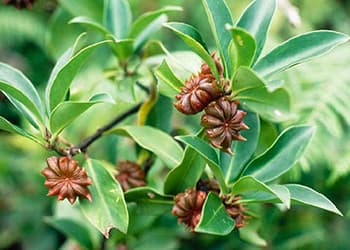
The requirements for growing star anise are simple:
- Full sun with dappled afternoon shade
- Moist but not soggy soil
- An inch of water per week
- Loamy soil with a pH level between 6.0 to 7.5
- Aged manure and rich compost
How To Harvest Star Anise
In favorable conditions, it will take your star anise plant at least six years to bear its first flower and fruits. The star-shaped fruits while they are still green and the pods are rounded. Star anise fruits will only change into their popular wooden and rusty color when they are thoroughly dried. They are ready for harvest when the seeds already have a distinctive aroma when pinched.
When they are ready for harvest, you will need to remove the fruits individually using garden shears. Dry the stars thoroughly under the sun until they turn reddish-brown. You may choose to leave the seeds in the pod or remove them before storing them in an airtight container. Stored star anise can last up to two years before losing its distinctive fragrance. Once it does, these seeds are no longer useful for cooking or medicine.
What Star Anise Is Good For and Natural Remedies Made From It
Star anise is a useful herb for various culinary needs but its importance extends beyond that. It is a powerful digestive aid that helps in relieving stomach cramps, gas, bloating, and indigestion. It is also used for treating cholera and fistula and used as a carminative.
In Traditional Chinese Medicine (TCM), star anise has an important part in maintaining the “chi,” or balance. Its cool yin and warm yang satisfy the body’s harmony for it to function properly. Aside from a digestive remedy, it is also a cure for various respiratory problems.
The star anise seeds are a rich source of B-complex and other important vitamins like riboflavin for improving the neurochemicals in the brain. Its seed pods also contain high levels of shikimic acid, which is used as a primary precursor in the anti-influenza drug Tamiflu.
The essential oil of star anise contains antibacterial, antifungal, and anti-inflammatory properties. Thus, it is used as an effective remedy for Candidiasis, mouth and teeth problems, and bronchitis.
Star anise is also effective in fighting free radicals with the presence of the antioxidant compound linalool. It prevents cellular damage that can cause heart problems and cancer. It also has a large amount of vitamin A and C content that reinforces its antioxidant property.
Topically, star anise oil is applied on the skin combined with carrier oil to ease rheumatism and joint pains. It is also applied to the skin and scalp for treating acne and head lice.
Star anise is also a mild sedative that can ward off sleep disorders.
Extract from star anise fruit is often used as an ingredient in skin conditioning. It is also a component added to some medicines and cosmetic products to mask their unpleasant odors.
Star anise is exceptionally valuable in TCM and adapted by Western medicine in the treatment of the following conditions:
- Influenza

- Herpes simplex
- Urinary tract infection (you might also want to try parsley tea)
- Candidiasis and other fungal infections
- Diabetes, heart diseases, and cancer
- Joint pain, back pain, rheumatism
- Asthma, bronchitis, and other respiratory problems
- Sleep problems (also try violet oil)
- Digestive complaints
What Parts Of Star Anise Are Used For Remedies
The fruit of the star anise is widely used in traditional medicine. It is also the part of the plant that contains the shikimic acid used in the production of Tamiflu.
Star anise seeds are chewed to relieve digestive disturbances. It is also crushed and steeped into a tea to alleviate sleep problems. The dried seed pod that is used in cooking is also used in aromatherapy, cosmetics, and some pharmaceutical applications.
⇒ A Before-Bed Recipe to Sleep Like a Baby Again (Video)
The essential oil of star anise is diluted with a carrier oil and used for a soothing massage. It is used in diffusers or inhalers to ease respiratory problems. A few drops of the star anise essential oil in tea and coffee can also boost digestive health.
Warming Star Anise Milk Recipe
Ingredients:
- 1 ½ (375 ml) whole milk
- 2 whole star anise
- 1 tsp molasses
Steps:
- Combine milk, molasses, and star anise in a pot. Turn the heat to medium and whisk constantly for about 7 minutes or until the mixture starts to boil.

- Remove from heat once it gets frothy and begins to boil over. Pour the star anise milk into a cup and enjoy it while hot.

How to Use this Remedy:
This healthy goodness of star anise and milk is best to go with your morning plate of bread. It is also a good cup for alleviating flatulence, bloating, and indigestion. It further boosts your immune system if you are suffering from flu.
The recommended dose of star anise for safe use is an average of 3g of fruit daily. Star anise essential oil use should not exceed 0.3 g per day.
What Plants Resemble Star Anise
| Features | Star Anise (Illicium verum) | Japanese Star Anise (Illicium anisatum) | Carambola Tree (Averrhoa carambola) |
|---|---|---|---|
 | 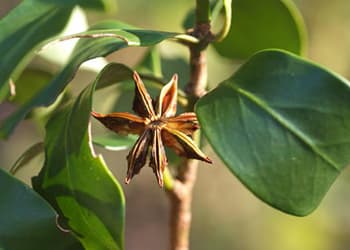 | 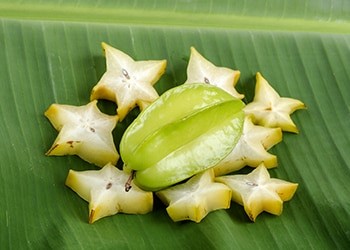 | |
| Size | 15 to 20 ft tall | 6 to 10 ft | Up to 30 ft |
| Leaves | Large; lanced-shaped; glossy; olive green; simple; alternate | Broadleaf; ovate; glossy/waxy; simple/ alternate | Deciduous; ovate; medium green |
| Flowers | White-pink/ dark red/ greenish yellow; large; solitary; bisexual; cup-shaped | Cream/ white/ yellow/ green; fragrant | Lilac with purple streak; small |
| Trunk | Erect; rounded; branched; white/grey bark | Erect/ rounded/ branched/ coarse | Erect; rounded; grey; branched |
| Fruit | Star-shaped carpels; green to wooden brown; aromatic | Star-shaped; green to brown; small; weak odor | Star-shaped; showy; fleshy |
| Scent | Warm, sweet, licorice-like | Mild earthy-floral scent | Fresh, sour, and fruity |
Warning And Cautions
Star anise is safe when taken as a licorice like flavoring in food. But there is not enough evidence to prove its safety in medicine. Thus, it should not be used by pregnant and lactating women.
When applied to the skin, some chemicals in star anise essential oil can cause allergic reactions.
Chinese star anise should also be properly identified from the toxic Japanese star anise. The latter can cause severe reactions like seizures, hallucinations and nausea.
Always check with your doctor when taking any kind of herbal medication like star anise.
Final Thoughts
Star anise is more than just a flavorful spice. It’s a powerhouse of health benefits with a long history in traditional medicine. Whether used to aid digestion, boost immunity, or add depth to culinary creations, its versatility makes it a valuable addition to any home. As with all natural remedies, moderation is key, and it’s important to ensure you’re using the safe, non-toxic variety. By incorporating star anise mindfully, you can enjoy both its rich licorice like flavor and its medicinal benefits.
My #1 Go-To Herb for Avoiding Influenza, Colds, and Severe Respiratory Illness
The Hidden Food Growing Fence (Video)
Soothing Elixir For Cold and Flu Season

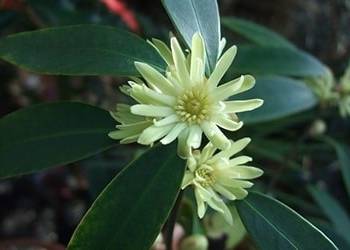 Leaves. The aromatic leaves of the star anise are large, lanced-shaped, and olive green in color. The broad leaves measure around 10 to 15 cm long and 2.5 to 5 cm across. They are alternate, simple, and are clustered at the end of the branches.
Leaves. The aromatic leaves of the star anise are large, lanced-shaped, and olive green in color. The broad leaves measure around 10 to 15 cm long and 2.5 to 5 cm across. They are alternate, simple, and are clustered at the end of the branches.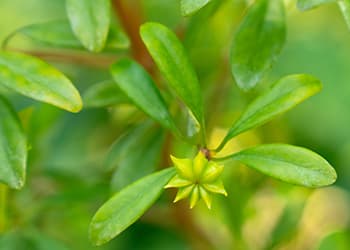 Fruits. Before the star-shaped fruit ripens out to its brown form, star anise fruits are green. It has six to eight carpels that form the star shape, each containing a seed. Each carpel is boat-shaped and about 10 mm long.
Fruits. Before the star-shaped fruit ripens out to its brown form, star anise fruits are green. It has six to eight carpels that form the star shape, each containing a seed. Each carpel is boat-shaped and about 10 mm long.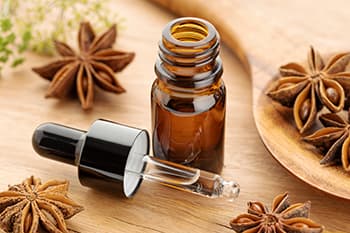
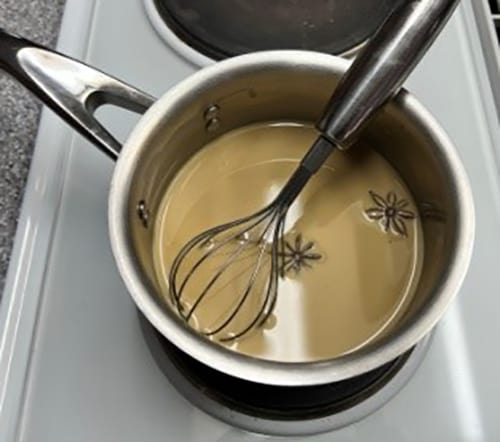


Ive heard that it also contains Suramin, which is apparently effective for treating covid, the effects of shedding, etc.
Mike Adams have talked about how to prepare shikimic acid from star anis with an expresso machine. Suramin is the name of a pharma medicin for sleep sickness. But this shikimic acid that you can get from Star anis drink in this way make something similar.
Suramin is being studied as it helps with autism. I would imagine there is something natural to cure autism as well. God bless and may all be healed from the earth and not a pharmacy!
Do you have a Star Anise tincture?
Hello Sandra,
Thank you for your comment.
You can make a Star Anise tincture using 200 ml Vodka, 1-2 tbsp Anise Seeds and 4-8 Star Anise.
People use star anise tincture to treat respiratory infections, lung swelling, cough, bronchitis, influenza, swine flu, and bird flu. It is also used to treat digestive issues such as upset stomach, gas, loss of appetite, and colic in babies.
Many blessings and good health!
It would appear that star anise is good for a lot of things I didn’t know about. I recently bought a huge bag of it for Asian cooking, which I’ve been doing at home more lately, and I was thinking about how my bag contains way too much to ever use by myself. But thanks to your email referencing it and having read more about it, I think it was a really great buy, and I’ll be using it for all kinds of other things, especially with milk and molasses! 😋
Hello Tricia,
Thank you for your comment! It’s nice to hear our article provided you with valuable information.
Many blessings and good health!
Awesome information – thank you!
Hi Rebecca,
Thank you for your kind words! We are very happy when our readers enjoy the
articles.
Many blessings and good health!
Thank you so much for sharing of your knowledge! It means so much to me!
God bless you!
Lots of love 🇳🇴
Hello Pia,
Thank you so much for your kind comment! We are glad to hear the article is helpful to you!
Many blessings and good health!
Thank you for the information 😊
Hello Rosy,
It’s great to hear that the information in the article is useful to our readers!
Many blessings and good health!
How would you use the tincture?
I’m trying to find the star anise plant, or even some fresh seeds for sprouting. I can grow it outside all year round in south florida, but no one seems to have it!! Where can I buy it, online or in person? Help please!!
We combine a little bit of star anise (I grind it slightly in a food processor or coffee grinder for a few pulses, not into powder, just enough to expose more of it) with chamomile flowers and lemon balm. My partner has ADHD and this helps him sleep; he also has acid reflux, so the star anise helps calm his belching. Chamomile usually knocks me out so I’m useless for days at a time, though this particular combination helps me sleep well for several hours and still be functional. Star anise seems to make a positive difference for our entire household.